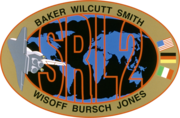STS-68
| STS-68 | |||||
 | |||||
| Uppdrag | ? | ||||
|---|---|---|---|---|---|
| Rymdfärja | Endeavour (7)[1] | ||||
| NSSDC-ID | 1994-062A[2] | ||||
| Färdens tid | 11 dagar, 5 timmar, 47 minuter, 10 sekunder | ||||
| Uppskjutning | |||||
| Startplats | Startplatta 39A vid Kennedy Space Center i Florida | ||||
| Start | 30 september 1994 | ||||
| Landning | |||||
| Landningsplats | Edwards Air Force Base | ||||
| Landning | 11 oktober 1994 | ||||
| Omloppsbana | |||||
| Varv | 182 st[3] | ||||
| Apogeum | 227 km | ||||
| Perigeum | 214 km | ||||
| Banlutning | 57,0° | ||||
| Sträcka | 8,7 miljoner km | ||||
| Besättning | |||||
| Befälhavare | Michael A. Baker (3) | ||||
| Pilot | Terrence W. Wilcutt (1) | ||||
| Uppdragsspecialister | Steven L. Smith (1) Daniel W. Bursch (2) Peter J.K. Wisoff (2) | ||||
| Nyttolastspecialister | Thomas D. Jones (2) | ||||
 | |||||
| Kronologi Rymdfärjeprogrammet | |||||
| |||||
STS-68 var ett amerikanskt rymdfärjeprogram 1994 där astronauterna åkte med rymdfärjan Endeavour. Uppskjutningen visades i Discovery Channel i ett speciallprogram om rymdfärjor 1994. Den sköts upp från Pad 39A vid Kennedy Space Center i Florida den 30 september 1994. Efter drygt elva dagar i omloppsbana runt jorden återinträdde rymdfärjan i jordens atmosfär och landade vid Edwards Air Force Base i Kalifornien.
Besättning
- Michael A. Baker (3)
- Terrence W. Wilcutt (1), Pilot
- Thomas D. Jones (2)
- Steven L. Smith (1)
- Daniel W. Bursch (2)
- Peter J.K. Wisoff (2)
Se även
Referenser
- ^ NASA Space Shuttle Launch Archive Arkiverad 4 januari 2013 hämtat från the Wayback Machine., läst 28 juli 2016.
- ^ ”NASA Space Science Data Coordinated Archive” (på engelska). NASA. https://nssdc.gsfc.nasa.gov/nmc/spacecraft/display.action?id=1994-062A. Läst 20 mars 2020.
- ^ Manned Astronautics - Figures & Facts Arkiverad 31 mars 2016 hämtat från the Wayback Machine., läst 28 juli 2016.
Externa länkar
 Wikimedia Commons har media som rör STS-68.
Wikimedia Commons har media som rör STS-68.
| ||||||||
| ||||||||||||||||||||||||||||||||
Media som används på denna webbplats
Författare/Upphovsman: Pascal (Flickr user: pasukaru76), Licens: CC0
Vostok spacecraft replica at the Technik Museum Speyer, Germany.
STS-66 Mission Insignia
The crew of the Space Shuttle mission STS-68 described by NASA as follows. :Standing are, left to right, Michael A. Baker, mission commander; and Terrence W. Wilcutt, pilot. On the front row are, left to right, Thomas D. Jones, payload commander; and Peter J. K. (Jeff) Wisoff, Steven L. Smith and Daniel W. Bursch, all mission specialists.
STS-64 Mission Insignia
STS-68 Mission Insignia







